How To Build A Massive Chicken Coop Run: A Step-By-Step Comprehensive Guides
- March 28, 2024
- 0 comment
Learn how to build a massive chicken coop run to ensure your chickens stay healthy, happy, and protected from predators. This guide offers detailed instructions, expert advice, and step-by-step insights, suitable for both experienced farmers and novice backyard chicken keepers, to construct a spacious and secure outdoor area for your flock.
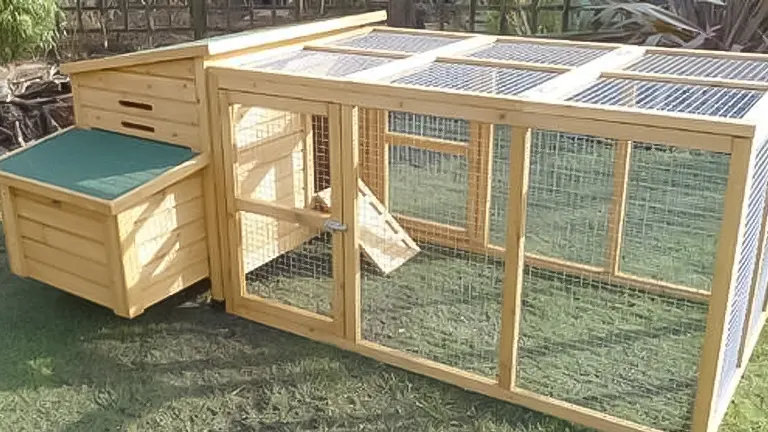
Let’s dive into the process of constructing a chicken run that not only meets your chickens’ needs but also withstands the test of time and elements.
List of How To Build A Massive Chicken Coop Run:
- Planning Your Chicken Coop Run
- Constructing the Frame
- Securing the Perimeter with Hardware Cloth
- Adding a Roof for Weather Protection
- Building and Installing a Secure Door
- Enhancing the Chicken Run
Understanding the Basics of Chicken Coop Runs
Before embarking on your building journey, it’s crucial to grasp what a chicken coop run is and its significance.
A chicken run is an enclosed outdoor area attached to or surrounding a chicken coop, providing birds with safe, predator-proof space to roam, forage, and enjoy sunlight and fresh air.
The primary goal is to balance freedom and protection, ensuring your chickens have ample space to exhibit natural behaviors while keeping them safe from potential threats.
Building Steps for a Durable Chicken Coop Run
1. Planning Your Chicken Coop Run
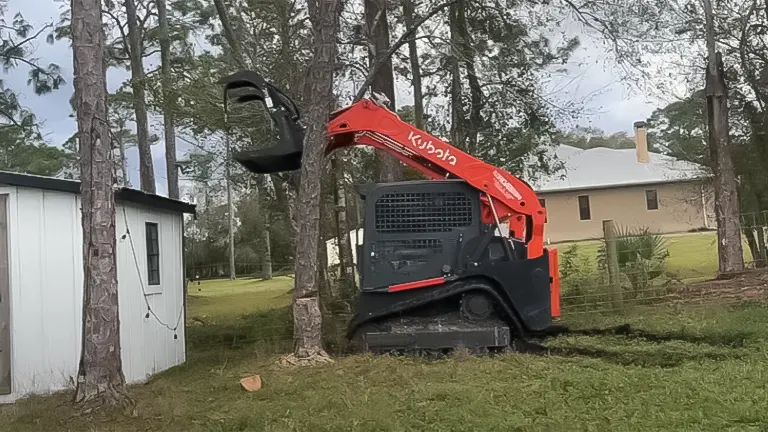
- Determining Size and Location: The size of your run should cater to the number of chickens you plan to keep. As a rule of thumb, allocate at least 10 square feet per chicken to prevent overcrowding and promote a healthy environment. Choose a location that offers a mix of sun and shade throughout the day, and consider the terrain for proper drainage.
- Selecting Materials: Opt for durable materials that can withstand weather conditions and deter predators. Pressure-treated wood for the frame, hardware cloth (not chicken wire) for the fencing, and a solid roofing material are recommended for longevity and security.
2. Constructing the Frame
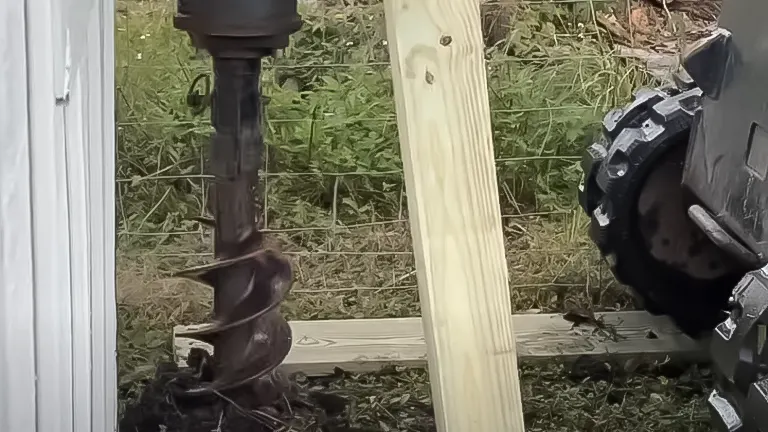
- Laying the Foundation: Start by marking the perimeter of your run and digging holes for the posts at least 2 feet deep to ensure stability.
- Installing Posts: Place 4×4 wooden posts in the holes and secure them with concrete. Make sure they are level and evenly spaced.
- Assembling the Frame: Connect the posts using 2×4 horizontal beams to form the frame. Use exterior-grade screws for assembly to prevent rust and corrosion.
3. Securing the Perimeter with Hardware Cloth

- Measuring and Cutting: Measure the sides of your frame and cut the hardware cloth accordingly, leaving extra length to bury underground for added predator protection.
- Attaching the Hardware Cloth: Fasten the hardware cloth to the frame using heavy-duty staples or screws with washers to ensure it’s tight and secure. Remember to cover all sides and the top to prevent predators from entering.
4. Adding a Roof for Weather Protection
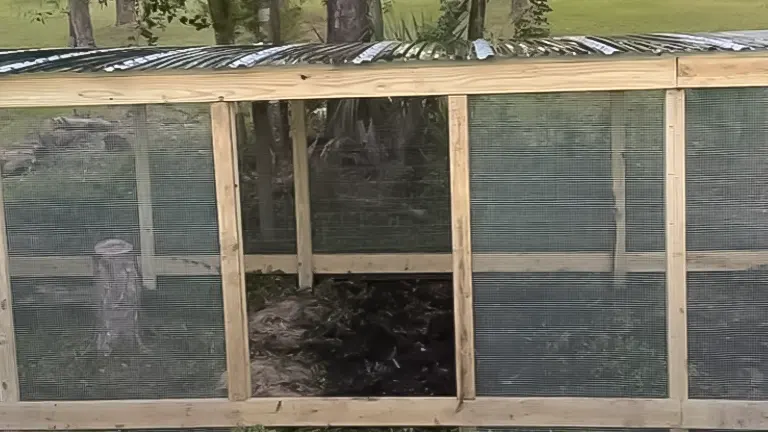
- Choosing Roofing Material: Select a roofing material that provides shade and shelter from the elements. Polycarbonate panels, metal roofing, or shingles are great options.
- Installing the Roof: Attach the roofing material to the top frame of the run. Ensure it’s properly secured and overlaps at the edges to prevent water leakage.
5. Building and Installing a Secure Door

- Constructing the Door: Build a door frame using 2×4 wood and cover it with hardware cloth. Make sure the door is large enough for easy access but secure enough to keep predators out.
- Hanging the Door: Install hinges and a sturdy latch on the door. Position the door frame within the run’s frame and ensure it opens and closes smoothly.
6. Enhancing the Chicken Run
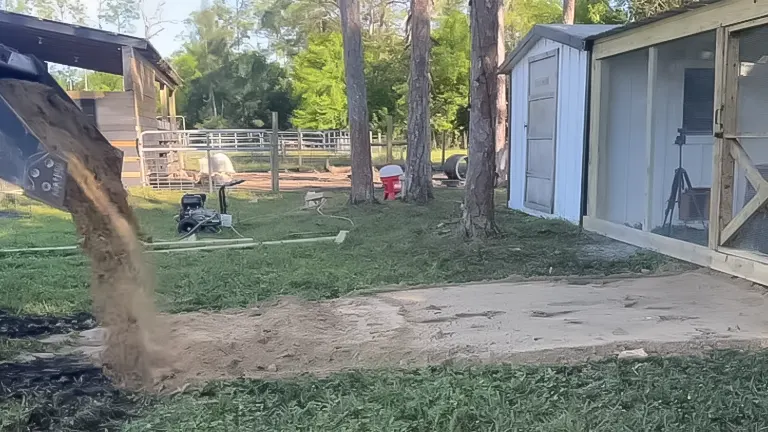
- Adding Perches and Shelters: Install perches and sheltered areas within the run for chickens to rest and hide. This enriches their environment and promotes natural behaviors.
- Providing Dust Bathing Areas: Create a dust bathing area with sand or fine dirt. Dust baths are essential for chicken health, helping them to maintain feather condition and prevent parasites.
Maintenance and Upkeep
Regular maintenance is crucial to keep your chicken run in top condition. Inspect the structure periodically for any signs of wear or damage, especially after extreme weather conditions. Keep the area clean, removing any hazardous objects or toxic plants that may have grown inside the run. Additionally, refreshing the ground with new soil or sand can help prevent the buildup of parasites and keep your chickens healthy.
Key Takeaways for Building a Massive Chicken Coop Run
- Plan meticulously: Consider the size, location, and materials carefully before starting your project.
- Invest in quality materials: Use durable, predator-proof materials for the frame, fencing, and roofing to ensure the longevity and security of your coop run.
- Ensure ample space: Provide at least 10 square feet per chicken to prevent overcrowding and promote a healthy environment.
- Prioritize security: Install a solid foundation, secure fencing, and a sturdy roof to protect your flock from predators and the elements.
- Maintain regularly: Perform periodic inspections and maintenance to keep the run in top condition and address any issues promptly.
By following these guidelines and putting care and attention into every step of the building process, you can create a massive chicken coop run that meets all your chickens’ needs. This not only contributes to their physical health but also to their overall happiness and productivity, making your venture into backyard chicken keeping a resounding success.
Related Articles:
- How to Keep Raccoons Away from Your Chicken Coop: Top Strategies
- How to Kill Rats in a Chicken Coop
- How to Clean a Chicken Coop with a Dirt Floor: Best Practices for Hygiene
- Raising Rare Peacocks: A Step-by-Step Hatching Guide
- 8 Beginner Chicken Care Mistakes To Avoid
- How to Make Incubator For Chicken Eggs: Insider Techniques and Tips
- How to Keep Ducklings Alive: A Step-By-Step for Method Guides
- 3 Reasons Your Chickens Stopped Laying Eggs
- What Should You Feed Your Chickens for Year-Round Egg Production? An Essential Guide
- How Do You Introduce New Chickens to Your Flock? A Step-by-Step Guide
- How to Create the Perfect Indoor Chicken Brooder: From Start to Outdoor Transition
- How to Create an Odor-Free Chicken Run: Enhancing Your Garden
- Easy Chicken Feed Savings and Coop Care Tips
- How to Ferment Chicken Feed: Discovering the Path to Robust Poultry
- Feeding Chickens with Your Garden: The Top Plants for a Healthy Flock
- Raising Chickens for Eggs: Easy Tips for Beginners
- Start Growing Animal Feed: A Beginner’s Guide to Homesteading
- Top 5 Chicken Coop Designs for Backyard Farmers: Ultimate Guide
- How to Create Your Own Black Soldier Fly Larvae Composting Bin: A DIY Guide
- How to Start A Black Soldier Fly Bin: A Step-by-Step Setup Guide
- Composting Chicken Manure: How to Boost Nitrogen Content
- Designing the Perfect Low-Maintenance Chicken Coop: Your Ultimate Guide
- Can You Put Lime in a Chicken Coop? Analyzing Safety and Best Practices
Final Conclusion
Building a massive chicken coop run requires thorough planning, quality materials, and meticulous execution, but the payoff is immeasurable in the health and happiness of your chickens. By providing them with a spacious and secure outdoor area, you’re ensuring their well-being and laying the groundwork for a successful and rewarding backyard chicken experience.
Remember, the key to a successful chicken run is not just in its construction but also in its adaptability. As your flock grows or your needs change, consider expanding your run or incorporating new features to enhance their living space further. The flexibility to adapt and modify your chicken coop run ensures it remains a safe, enjoyable, and enriching environment for your chickens throughout their lives.
Frequently Asked Questions
- How much space do I need for a chicken run?
Ideally, each chicken should have at least 10 square feet of space in the run. For example, a flock of 10 chickens would require a minimum of 100 square feet. However, more space is always better if you have the room. - What materials are best for building a chicken run?
The best materials for a chicken run include pressure-treated wood for the frame, hardware cloth (instead of chicken wire) for the sides to prevent predator access, and durable roofing materials like polycarbonate panels or metal roofing to protect from the elements. - How do I protect my chicken run from predators?
To protect against predators, bury the edges of your hardware cloth at least 12 inches deep around the perimeter. Use secure latches on all doors and ensure the roof is well-attached and predator-proof. Regularly inspect the run for potential weak spots. - Can I attach the run to an existing chicken coop?
Yes, attaching the run to an existing coop is a great way to provide your chickens with easy access to outdoor space. Ensure the connection is secure and predator-proof. - How high should the walls of my chicken run be?
Walls should be at least 6 feet high to prevent chickens from flying over and to deter most predators. Adding a roof or covering the top with hardware cloth is also recommended. - What type of floor is best for a chicken run?
Natural ground is generally best for chicken runs, allowing chickens to scratch and forage. However, in areas with high predator risks, consider burying hardware cloth beneath the run for added protection. - Do I need a roof on my chicken run?
A roof provides protection from predators and the elements. It’s especially important in areas with harsh weather conditions. Clear or semi-transparent materials can offer sunlight while protecting your flock. - How can I ensure my chicken run is easy to maintain?
Design your run with maintenance in mind. Include a human-sized entry door for easy cleaning, and consider a sloped floor towards a drainage point to prevent water accumulation. Removable panels or sections can also make cleaning easier. - What features should I include inside the chicken run for my chickens’ well-being?
Include perches, dust bathing areas, and sheltered spots for your chickens to rest and hide. These features encourage natural behaviors and provide comfort and security for your flock. - 1Can I use chicken wire for the run?
While chicken wire can keep chickens in, it’s not as effective at keeping predators out due to its larger openings and weaker material. Hardware cloth, with its smaller mesh size and stronger build, is a safer option for protecting your chickens.
For more expert advice on poultry care and coop construction, explore our comprehensive guides, discover our top recommendations in our best practices section, and delve into in-depth discussions in our review section. Happy Building!

Edward Smith
Forestry AuthorWoodworking is about more than crafting; it's a harmonious connection with nature, mastering tools, and preserving our environment. I'm here to share my knowledge and experiences with you, forging a future where we can embrace wood's beauty and utility while safeguarding our forests' health and diversity.




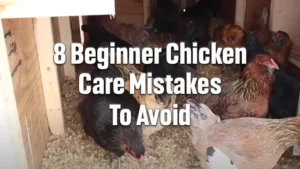








Leave your comment